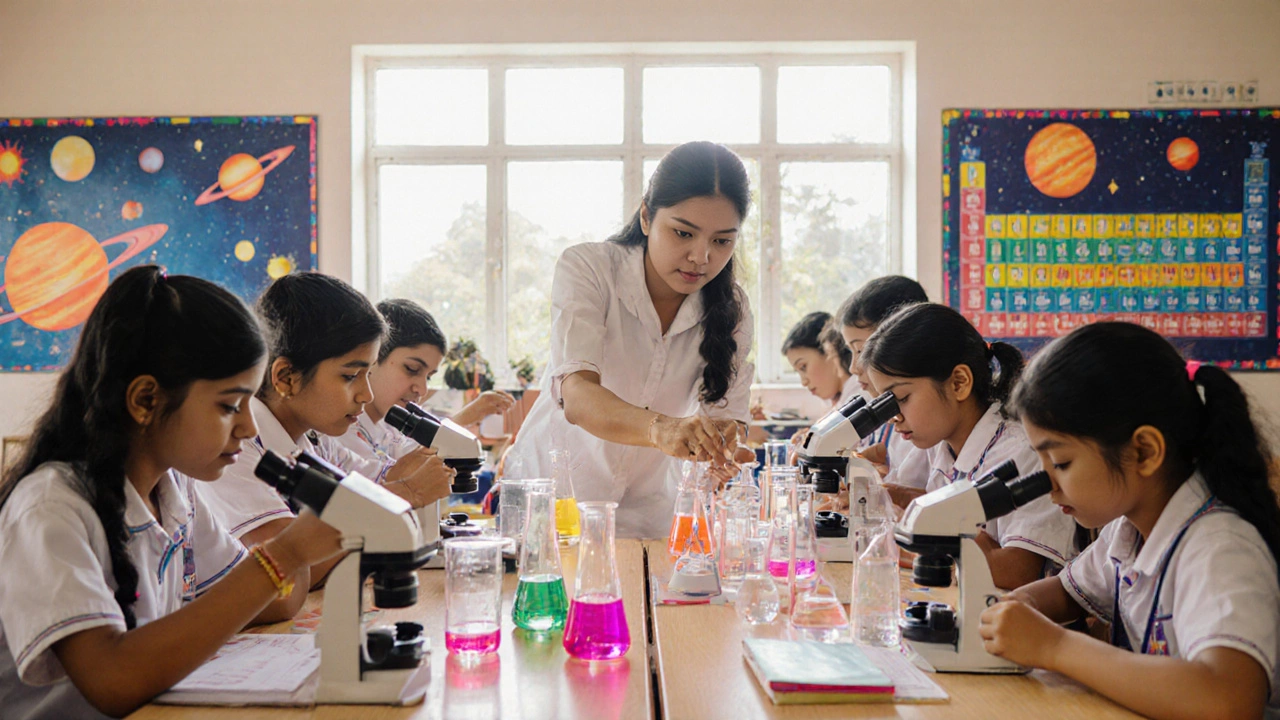CBSE vs Other School Boards Comparison Tool
Select Your Priorities
Choose what matters most to you when selecting a school board for your child:
If you're moving to India or choosing a school for your child, you've probably heard the term CBSE schools. But what exactly are they? And why do millions of families in India pick them over other options? CBSE stands for Central Board of Secondary Education. It's not a school itself-it's the board that sets the rules, syllabus, and exams for thousands of schools across India and even abroad. These schools follow the CBSE curriculum, which is designed to be uniform, exam-focused, and nationally recognized.
How CBSE Schools Work
CBSE schools aren't owned by one organization. They're run by private groups, religious trusts, or even state governments-but they all agree to teach the same syllabus, follow the same exam pattern, and use the same textbooks. This means a student in Delhi learns the same science topics in Grade 8 as a student in Kerala or Dubai. The board updates the curriculum every few years to keep up with changes in education, technology, and global standards. The latest revision, effective from 2024-25, includes more project-based learning and reduces rote memorization.
CBSE schools cover classes from Kindergarten to Grade 12. Students take two major exams: the Class 10 board exam and the Class 12 board exam. These aren't just school tests-they're national exams graded by the same board. Passing these exams gives students a certificate that's accepted by colleges and universities all over India, and even in countries like the UK, Canada, and Australia.
Why Parents Choose CBSE Schools
One big reason families pick CBSE is mobility. If your job takes you from Mumbai to Bhopal, your child won't fall behind. The syllabus is the same everywhere. That’s not true for state boards, which vary wildly by region. For example, a student in Maharashtra follows the Maharashtra State Board, which teaches history differently and uses different textbooks. Switching schools there means relearning entire subjects.
CBSE also prepares students well for competitive exams. The Class 12 syllabus aligns closely with entrance tests like JEE Main, NEET, and AIIMS. That’s why so many students aiming for engineering or medicine end up in CBSE schools. The board even releases sample papers and previous years' question banks that match the difficulty level of these exams. Many coaching centers design their programs around CBSE content because it’s predictable and standardized.
Another advantage? English is the primary medium of instruction in almost all CBSE schools. That gives students an edge in higher education and global careers. While some state boards teach in regional languages, CBSE schools focus on building strong English reading, writing, and speaking skills from early grades.
What’s Taught in CBSE Schools?
The CBSE syllabus is divided into subjects by grade. In primary school (Grades 1-5), students learn basic math, science, environmental studies, English, and one regional language. From Grade 6, they add subjects like Social Science and Computer Science. By Grade 8, students start preparing for the Class 10 board exam, which covers five core subjects: English, Hindi, Mathematics, Science, and Social Science.
In Grades 11 and 12, students choose a stream: Science, Commerce, or Humanities. Science students take Physics, Chemistry, Biology or Computer Science, and Mathematics. Commerce students study Accountancy, Business Studies, Economics, and either Mathematics or Informatics Practices. Humanities students pick from History, Political Science, Geography, Psychology, and Sociology.
What’s different now? CBSE has cut down on content overload. In 2024, they removed 30% of the syllabus from Class 9 to 12 to reduce pressure. Instead of memorizing long answers, students are now expected to explain concepts, solve real-life problems, and present projects. For example, in Biology, instead of just labeling parts of a cell, students might design a model showing how oxygen moves in and out of cells.

How CBSE Compares to Other Boards
Many parents wonder how CBSE stacks up against ICSE, state boards, or IB schools. Here’s a quick comparison:
| Feature | CBSE | ICSE | State Board (e.g., Maharashtra, Tamil Nadu) |
|---|---|---|---|
| Curriculum Focus | Exam-oriented, science and math heavy | Comprehensive, literature and language rich | Regional language and local content |
| Medium of Instruction | Primarily English | English | Often regional language |
| Exam Difficulty | Standardized, predictable | More detailed, subjective | Varies by state, often easier |
| Recognition for Higher Ed | Widely accepted across India and abroad | Good in India, less known abroad | Best within the state |
| Best For | Students aiming for JEE, NEET, or moving cities | Students strong in English and humanities | Students staying in the same state |
ICSE (Indian Certificate of Secondary Education) is more detailed and emphasizes English literature and project work. But it’s heavier on reading and writing, which can be overwhelming for some students. State boards are easier to pass but don’t offer the same national recognition. CBSE hits a sweet spot: balanced, structured, and aligned with top career paths.
What Makes a Good CBSE School?
Not all CBSE schools are the same. Just because a school says it’s CBSE doesn’t mean it delivers quality. Look for these signs:
- Teachers trained in CBSE guidelines-ask if they attend board-approved workshops.
- Access to lab equipment for science experiments. A good school doesn’t just teach theory-it lets students do experiments.
- Regular mock exams that mimic the real CBSE pattern. This helps students manage time and reduce exam stress.
- Transparent grading. CBSE schools should show how marks are broken down: 80% for final exam, 20% for internal assessment.
- Co-curricular support. CBSE now requires schools to include sports, arts, and life skills in the report card.
Some schools focus too much on rankings and push students into tuition centers. A healthy CBSE school balances academics with mental well-being. Check if they have counselors, no-homework weekends, or student feedback systems.
Challenges and Criticisms
CBSE isn’t perfect. Some critics say it’s too exam-driven. Students often feel pressured to score high, especially in Class 10 and 12. The board has tried to fix this by introducing pass/fail options in Class 10 and reducing the weight of final exams. But in practice, parents and schools still treat every test like a life-or-death event.
Another issue? Rural access. While urban CBSE schools have smart classrooms and online resources, many rural CBSE-affiliated schools lack basic infrastructure. The board provides guidelines, but doesn’t fund them. So quality depends on the school’s budget and management.
Also, CBSE doesn’t offer vocational streams until Grade 11. If a student wants to learn carpentry, nursing, or graphic design early on, they might need to look at other systems like NIOS or state vocational boards.
What Comes After CBSE?
After Class 12, CBSE students have clear paths. Most go for engineering (JEE), medicine (NEET), or commerce (CA, CS, CMA). Others choose arts, design, or law. Because CBSE is nationally recognized, students can apply to colleges anywhere in India without needing extra certifications.
For those going abroad, CBSE scores are accepted by universities in the US, UK, Canada, Australia, and Germany. Some universities even ask for CBSE mark sheets instead of SAT or A-levels. The board also partners with organizations like Cambridge and Pearson to offer international certifications alongside the Indian board exam.
Many CBSE schools now offer dual certification-students get both the CBSE certificate and an international qualification like the Cambridge IGCSE or IB Diploma. This gives them more options when applying overseas.
Final Thoughts
CBSE schools are not about being the fanciest or the most expensive. They’re about consistency, clarity, and connection. If your child might move cities, wants to take competitive exams, or plans to study abroad, CBSE gives them a reliable foundation. It’s not the only path-but for millions of Indian families, it’s the most practical one.
When choosing a CBSE school, don’t just look at the name on the gate. Visit the classrooms. Talk to teachers. Ask how they handle student stress. The best CBSE schools don’t just teach the syllabus-they teach students how to think, not just how to memorize.
Is CBSE better than ICSE?
CBSE is better if your child plans to take national competitive exams like JEE or NEET, or if you move frequently. ICSE is stronger in English literature and project-based learning, making it a good fit for students who prefer detailed, analytical subjects. But CBSE’s syllabus is more aligned with engineering and medical entrance tests.
Can I switch from a state board to CBSE?
Yes, you can switch, but it’s easier before Grade 9. The syllabus differences between state boards and CBSE get bigger after Grade 8. Students switching in Grade 10 or 11 may need extra coaching to catch up, especially in Science and Math. Most CBSE schools accept transfers but may require a bridging test.
Are CBSE schools only for middle and upper-class families?
No. While many private CBSE schools charge high fees, there are also government-run CBSE schools that are free or low-cost. The board allows schools to operate on different budgets. In cities like Delhi and Lucknow, you’ll find CBSE schools in both elite neighborhoods and public housing areas.
Does CBSE have a foreign curriculum?
CBSE itself doesn’t offer a foreign curriculum, but many CBSE-affiliated schools partner with international boards. For example, some schools offer the Cambridge IGCSE alongside CBSE Class 10, or the IB Diploma with CBSE Class 12. This lets students earn two qualifications at once.
How often does CBSE change its syllabus?
CBSE reviews its syllabus every 3 to 5 years. Major updates happened in 2019, 2021, and 2024. The 2024 changes focused on reducing content, adding real-life applications, and reducing exam pressure. Schools are expected to adopt these updates immediately after official notification.
Do CBSE schools teach coding?
Yes. Coding is part of the CBSE curriculum from Grade 6 onwards. Students learn Python basics, algorithms, and problem-solving using computers. By Grade 11, they can choose Informatics Practices as a subject, which includes database management and web development. Many schools now have coding clubs and robotics labs.
Next Steps for Parents
If you’re considering a CBSE school, start by checking the official CBSE website for the list of affiliated schools in your area. Visit at least three schools. Ask to see their last year’s Class 10 results and how many students got into top colleges. Talk to current parents. Ask how they handle homework overload. And remember-your child’s well-being matters more than a high ranking. A good CBSE school doesn’t just produce top scorers. It produces confident, curious learners.

